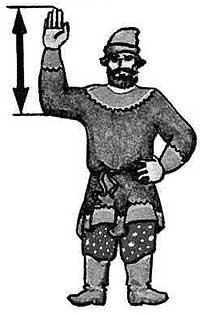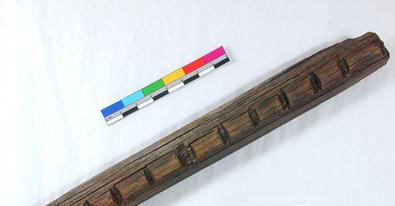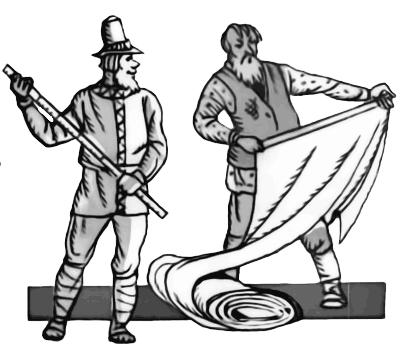The elbow as part of the body, or rather, the "place of the fold on the arm", is well known to everyone. Also, no one causes questions or surprise at the second meaning of the word related to clothing. This is the place on the sleeve where it is in contact with the elbow joint. But today, not everyone already knows that for several centuries this word was widely used in the third, now obsolete meaning: elbow - a measure of length. At different times, it was used by many peoples in different parts of the world, including the inhabitants of the first ancient Russian state, and later of the Russian Empire.
Elbow - a measure of length?
The reason for the emergence of a word so unusual from the point of view of a modern person was actually quite simple. Before the advent of traditional centimeters and other units of measurement that are familiar to us today, the easiest way was to focus on what is familiar. These, for example, are various parts of the human body. Moreover, they were always “with themselves”. What is the length of the fingers and hand or the size of the average step? How much weight can a person lift at a time? What is the distance between the extended thumb and forefinger? Answers to these and other similar questions helped in ancient times determine the weight, length, and height of objects. Of course, the data obtained were approximate and usually varied, but in the absence of a common measurement system for all, they almost completely solved the problem of determining the values. Trying to improve and improve the results of their labors, people gradually came to the conclusion that in certain territories (sometimes even within the same state), quite specific data began to be assigned to each unit.
What did our compatriots use in antiquity
An ancient measure of length on Russian lands could have different names: apex, span, elbow, arshin (or step), fathom, verst. Some appeared earlier, others a little later, but all of them for quite a long time constituted a system of calculation generally accepted in the state . Small units were widely used in the domestic sphere, the last two - most often for determining large distances between postal stations and settlements.
Measurement by the elbow was widespread in the trading business and at first it was ideally suited to merchants and shopkeepers when selling small pieces of canvas, canvas, and cloth. With his help, the landowners could easily determine the length of a hemp rope or wool yarn in a skein. An elbow was also used in construction, for example, to determine the size of window and door openings.
In Russia, there were several options for this simple and convenient measure. So, a large elbow was distinguished, which was two times superior to the usual one and was the length of the arm from the shoulder to the tips of the fingers. For some time it was the most popular measurement system in trade (later arshins were measured in a similar way). There was also an incomplete, two-palatine, ivanian elbow (it was officially fixed in Veliky Novgorod and its environs). For at least five to six centuries, this ancient measure of length has been officially recognized and used throughout the Russian state. And the word "elbow" itself has been associated for a very long time, primarily with this meaning. And only from the beginning of the 16th century, in written sources, it began to be assigned to it a well-known meaning to us - a fold on the arm.
How to determine the size of the elbow
The main question that usually interests people who are discovering today the obsolete meaning of the word: "How much is an elbow?"
In search of an answer, you should first turn to official sources - explanatory dictionaries. Their very famous and authoritative compilers S. Ozhegov and D. Ushakov in one of the meanings give a similar definition, now already marked “obsolete”. Their elbow is a measure of length used on the territory of the Old Russian state and equal to about half a meter. However, if you turn to other literature, you can meet completely different figures. Most often, 46-47 cm are given. Somewhere you can find a size of 38-46 cm and even more than 50 cm. Naturally, the question naturally arises: "What was the elbow equal to in the old days and what caused such a difference in determining its length?"

Arguing on this topic, it should be remembered that initially, even before the distribution of numbers and units of measurement of various quantities, the “source” for determining their sizes, including the same elbow, was the parts of the human body. However, all people have different physical characteristics and capabilities. Consequently, the distance from the elbow bend of the arm to the tip of the middle finger or clenched fist (this is how the size of this unit was determined) was individual for each person. So it turned out that in almost every province in the Russian state the elbow length was different from the others. In order to somehow come to uniformity and put things in order in at least one locality, city governors sometimes installed specific samples for this unit of measurement, and then all traders in markets and shops and buyers were already guided by them. This order existed for quite some time: from the XI (at least, the first mention of the elbow in the “Russian Truth” of the Grand Duke Yaroslav the Wise dates back to this time) and up to the 16th century. Then it was replaced by arshin, which operated in the Russian Empire until the advent of modern units of measurement.
From the history of determining the size of the elbow
Very often, the key to understanding historical phenomena that have become a thing of the past is written sources, which for centuries have preserved evidence of events. So the data on the existing units of measurement can be obtained from books.
One of the first ancient Russian monuments of literature was “The abbot of Hegumen Daniel to the Holy Land”, written at the very beginning of the XII century. Its author, a former monk, led the pilgrimage campaign in Palestine and, based on its results, drew up a kind of report. It was this work that partly helped contemporaries find the answer to the question: "How much is an elbow?"
The fact is that the “Walking ...” gives a detailed description of the main shrine of Jerusalem - the Holy Sepulcher, including its actual dimensions. So, Daniel noted that the length and width of the monument are related as four elbows to two. Later, already in the middle of the XVII century, another Russian clergyman - Patriarch Nikon - realized a very unusual, and for some even a daring dream. On the banks of the Istra River, under his leadership, the majestic Resurrection New Jerusalem Monastery was erected , practically repeating, but on a smaller scale, the famous Palestinian buildings. It also contained an exact copy of the Holy Sepulcher, which had the same dimensions as in the Holy Land, but only indicated by builders in arshins and tops. It was these two facts associated with the names of Daniel and Nikon that subsequently made it possible, by comparing the available data and simple arithmetic calculations, that officially 1 elbow was equal to 46.6 cm.This figure is most often found at its mention.
Ivan's elbow
There is other evidence of what this popular unit of length was.
So, in the middle of the twentieth century, during archaeological excavations on the territory of the ancient city of Nizhny Novgorod, quite interesting from a historical point of view and things related to this topic were discovered. One of them was a rod, most likely made of a hollow trunk of juniper and well polished by the palms of the hands (this fact proves that it was constantly in use). And evenly and neatly cropped edges indicated that the thing was preserved in its original form. After examination and determination of the age of this unusual “wand”, it was concluded that it could be a kind of standard measure and acted in the city around the 11th-12th centuries. At the same time, the length of the elbow (and the found rod in magnitude corresponded to it to a greater extent) was 54.7 cm.

A few years earlier, a fifteen-centimeter fragment of a similar ruler was found in the same area, most likely related to a later period, the XIV century. Despite the damage, it even preserved the Slavic inscription "swathe-worms".
These findings suggest that such standards could indeed exist, if not in all, then in the largest provincial centers. And they played the role of a control measure of length at sale. Thus, the authorities tried to protect the interests of traders and buyers.
Which is longer: fathom or elbow?
In 1017, the famous monk of the Kiev Pechersk Lavra Nestor, who went down in history as the first chronicler, mentions another primordially Russian unit of measurement. This is fathom, which occupied the next place after the elbow in the scale. Its length was again approximate and was determined in several ways. The most famous and widespread is the distance between the tips of the fingers of the arms extended apart in different directions (this is a fist fathom). Another measurement option is from top to bottom from shoulder level to the floor. Finally, a straight line diagonally from the toe of the left foot to the tips of the fingers of the right hand raised up (oblique fathom). The word itself was formed from the old Russian verb "squeeze", which had the meaning "as far as you can reach your hand." All this already, in fact, gives an answer to the question of what is longer - fathom or elbow.
For more accurate information, get acquainted with the following facts. In Russia, more than ten names of different options for sazhen were distributed: small, oblique (or oblique), city, fly, imperial, masonry, and others. Their size ranged from 1.34 meters to two and a half or more. In addition, the story of the found stone with an inscription in the Slavic language is known. Prince Gleb, mentioned in it, undertook to measure the distance in the district, and to fix the results he used the most suitable measure of length for this - fathom. Much later, topographers, having studied the record and the terrain, concluded that on average it was about one and a half meters. These data coincided with the sizes of fathoms, which were indicated by architects in various sources related to construction. Also, it often served to determine not very large distances.
Thus, the analysis of the data leads to the conclusion that a larger measure of length is fathom. The elbow was an order of magnitude shorter, which meant it was more suitable for measuring small-sized objects in everyday life.
Arshin instead of the elbow
From the sixteenth century, elbow measurement is gradually becoming a thing of the past. Moreover, several reasons for this phenomenon can be identified. One of them is due to the fact that at the turn of the XVI-XVII centuries the “Trading Book” was published, intended for merchants and other sellers. She introduced a new measured unit - arshin - and fixed its approximate size - 71 cm. It was determined by measuring the distance from the shoulder to the end of the middle finger of an outstretched arm. Unlike the original Russian “elbow”, this word was “foreigner”. It came to Russia from the East during the period of active development of trade relations between countries. The book gave a table of measures of length, in which the following ratio of the new and old units was indicated: two arshins equaled three elbows. For some time they existed in parallel and differed in the scope of use. Russian merchants still resorted to the elbow, while foreign merchants to the arshin. Gradually, the latter began to be used more and more often. The first began to lose its significance, and this despite the fact that it was he who for a long time was the main unit of measure in trade.
Another reason lies in the fact that not all goods sold are conveniently wound on the elbow. In meters, the same fabric was much more convenient to measure. In addition, despite all the steps taken in the provinces, the size of the elbow was significantly different among different merchants. And this ultimately led to an increase in discontent on the part of the population. As a result, by the end of the XVII century, the original Russian unit of measurement - the elbow - almost completely went out of use. Arshin also survived in Russia until the beginning of the twentieth century, when a new system of measurement, close to the European one, was introduced.
A certain role in the “struggle” of the Russian and “foreign” units was also played by the standards - the so-called wooden rulers with the divisions applied to them. It was they who soon began to play the role of arshin. The next stage of its approval in Russia is celebrated at the moment when the small span and apex began to correlate with the new unit. And in order to eliminate consumer fraud (each merchant initially measured the goods with his ruler - just remember the saying “Measure on your arshin”), the state introduced the so-called “state arshin”, which had special metal rivets at the ends. Naturally, such a length measurement was more convenient than using the elbow.

As for the origin and meaning of the word “arshin”, there was no unambiguous explanation. Some associated his appearance with the Turkic “ar” (“land”), others - with the Persian “arsh” (“elbow”). Moreover, supporters of the first option concluded that when arshins appeared, it could correlate with the size of a human step.
The past of the country in folklore
For about a hundred years in Russia there has been a new system for measuring length, but evidence of the use of Old Russian units can often be found in works of art and folklore. In the latter case, this is not only evidence of the historical development of the people and the country as a whole, but also a kind of moral standard that has been developed for centuries.
For example, the well-known proverb: “Himself with a marigold, and a beard with a elbow” indicates a person with an inconspicuous appearance, but
with significant authority in the society, earned thanks to the mind, great life experience or just a stable social position. This interpretation is rooted in pre-Petrine times. Then the magnificent well-groomed beard was a pride of noble people. That is why, having lost it on the orders of Peter the Great, the boyars felt humiliated and insulted. This is how the unit of length "elbow" began to be used in a figurative, namely, estimated, value.
Another example. Proverb: “In the wrong hands a fingernail with a elbow”, which perfectly characterizes an envious and greedy person. Or: “You’ll say it on a fingernail, but will be retold on an elbow” - about an unkind rumor that has the property of spreading quite quickly.
Elbow in other countries of the world
A similar measure of length was used not only in Russia. It was known to many peoples since ancient times (and in some countries of Europe it operated until the beginning of the 19th century). As you can already guess, the size of the elbow in each country was different. As an example, the following international table of measures of length with this unit can be given.
Country | Size in centimeters |
Egypt (small) | 45 |
Egypt (imperial) | 52,5 |
Persia (pygon) | 38.5 |
Persia (imperial) | 53.3 |
Greece | 46.3 |
Rome | 44,4 |
Tunisia | 47.3 |
Far East | 45 |
Like Russia, there were also varieties of the elbow: large, small and even double (99-99.6 cm) - the Sumerian Tsar Lagash Gudea, who operated in the 22 century BC. e. Typically, traders measured them cloth or other similar goods.
A relic of the past or a convenient version of the line?
Nowadays, the outdated meaning of the word "elbow" - a measure of length, of course, is no longer used, and knowledge of its history to a greater extent indicates the intellectual level of human development. However, in life there are often cases when you urgently need to measure something, and there is neither a ruler nor a so-called centimeter nearby. This is where the man-made measures common in the distant past can come to the rescue. They will help in a split second to determine the size of small objects. To do this, it’s enough to know, for example, what is the size of the distance between the extended index finger and thumb (this is an old Russian span) or arms spread out to the sides (fly fathom).
It is very simple to find out what the elbow is equal to. The distance from the tip of the middle finger to the elbow is your individual measure of length.